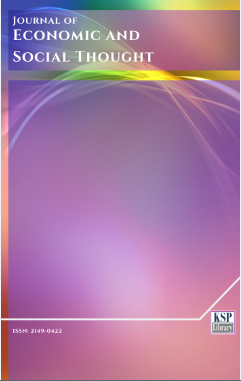Application Review Authority to the Concept of Formal and Becoming a New Concept of Human Talent Management
Abstract
Abstract. The aim of this paper is to analyze the concept of formal authority in organizations, using a theoretical discussion of its components, their mainstreaming in the administrative process, and its effect on the proactive development of business objects, pretending to determine if this variable is proactive or not, in the development of high performance practices in Human Resource Management, and whether or not a restriction, for people to become their strategic base and / or competitive. We also try, from a case study to determine the effect of expression authority in non-hierarchical designs, the effects of structural position in organizations, the impact of leadership, the relationship of structures and the charges regarding the successes and achievements of the organization, the effect on intra-relationships and communication, imposing, authoritarian, non-cooperation with the lack of consistency with individual purposes, mission and Provisional Record, the continuum of bad decisions, relationship with management and control, and finally connect all these elements with the current organizational individuals, immersed in a knowledge society..
Keywords. Hierarchy, Authority, Pyramid structure, Subordination, competitiveness, Job performance.
JEL. E24, J24, O15.
References
Alabanese, R., (1988). Management. Cincinati: South Western Publishing.
Arthur, J.B., (1994). Effects of human resource systems on manufacturing performance and turnover, Academy of Management Journal, 37(3), 670-687. doi. 10.2307/256705
Barney, J.B., (1991). Firms resources and sustained competitive advantage, Journal of Management, 17(1), 99-120. doi. 10.1177/014920639101700108
Cremer, J. (1993). Corporate culture and shared knowledge, Industrial and Corporate Change, 2(3), 351-386. doi. 10.1093/icc/2.3.351
Cresby, P. (1987). La Calidad No Cuesta (Qualityis Free), México, Compañía Editorial Continental S.A.
Delery, J., & Doty, H. (1996). Modes of theorizing in strategic in strategic human resource management: Test or universalistic, contingency and configurational performance predictions, Academy of Management Journal¸ 39(4), 802-835. doi. 10.2307/256713
Delery, J.E., (1998). Issues of fit in strategic human resource management: implications for research, Human Resource Management Review, 8(3), 289-309. doi. 10.1016/S1053-4822(98)90006-7
Eisenberger, R., Huntington, R., Hutchison, S., & Sowa, D. (1986). Perceived organizational support, Journal of Applied Psychology, 61(2), 500-507.
Eisenhardt, K.M. (1989). Building theories from case study research, Academy of Management Review, 14(4), 532-550. doi. 10.5465/AMR.1989.4308385
Fierman, J. (1993). The Contingency Work Force. 30-35. En Fortune 1994.
Foucoult, M. (1983). El Sujeto y el Poder. Beyond structuralism and hermeneutics. Chicago University Press, 1983.
Guest, D. (1987). Human resource management and industrial relations, Journal of Management Studies, 24(5), 503-521. doi. 10.1111/j.1467-6486.1987.tb00460.x
Huselid, M.A. (1995). The impact of human resource management practices on turnover, productivity, and corporate financial performance, Academy of Management Journal, 38(3), 635-672. doi. 10.2307/256741
Ichniowski, C., Shaw, K., & Prennushi, G. (1997). The effects of human resource management practices on productivity: A study of steel finishing lines, American Economic Review, 87(3), 291-313.
Kofman, F., & Senge, P.M. (1993). Communities of commitment: the heart of learning organizations, Organizational Dynamics, 22(2), 5-23. doi. 10.1016/0090-2616(93)90050-B
Kreps, D. (1990). Corporate culture and economic theory, en J. Alt y K. Shepsle (eds.) Perspectives on positive political economy, Cambridge, pp. 90-143.
Lawler, E.E. (1986). High-Involvement Management: Participative Strategies for Improving Organizational Performance, Jossey Bass, San Francisco.
Lee, J., & Miller, D. (1999). People matter: commitment to employees, strategy and performance in korean firms, Strategic Management Journal, 20(6), 579-593. doi. 10.1002/(SICI)1097-0266(199906)20:6<579::AID-SMJ37>3.0.CO;2-C
Lengnick-Hall, C.A., & Lengnick-Hall, M.L. (1988). Strategic human resource management: a review of the literature and a proposed typology, Academy of Management Review, 13(3), 454-470. doi. 10.5465/AMR.1988.4306978
Montoya, J. N. (2001) La autoridad formal una restricción en las organizaciones. Unapropuestatoc, The International Journal Business and Finance Research. IBFR. Global. Issn. 1931- 0277 issn. 1931- 0269 issn. 1931-1285
O´Reilly, C. (1989). Corporations, cultures and commitment: Motivation and social control in organizations, California Management Review, 31(4), 286-303.
Ordiz, M. (2002). Prácticas de alto rendimiento en recursos humanos: concepto y factores que motivan su adopción, Cuadernos de Economía y Dirección de la Empresa, 12, 247-265.
Porter, M. (1999). Estrategia Competitiva: Técnicas para el Análisis de los Sectores Industriales y de la Competencia. México. Compañía Editorial Continental, SA..
Porter, M. (1999). Ser competitivo, nuevas aportaciones y conclusiones. Página 166, 168, Ediciones Deusto, 1999. Bilbao:478 p. España
Porter, M. (1987), Ventaja Competitiva, p.166-168. C.E.C.S.A., México.
Reyes, A. (2000). Administración de Personal. Relaciones Humanas.107-108.I Parte. Editorial Limusa. México.
Salas, V. (2000) La cultura de las organizaciones, Cuadernos de Economía y Dirección de la Empresa, 7, 341-364.
Sashkin, M. (1984). Participative management is an ethical imperative, Organizational Dynamics, 12(4), 5-22. doi. 10.1016/0090-2616(84)90008-1
Sitter, & Schumacher, (2000). The flexible business: Integrated Organizational Innovation'. Edit. Ducht Technology, labour and organizational research Programme.
Truss, C., Gratton, L.; Hope-Haliley, V., McGovern, P., & Stiles, P. (1997). Soft and hard models of human management: a reappraisal, Journal of Management Studies, 34(1), 53-73. doi. 10.1111/1467-6486.00042
Valle, R., Martin, F., Romero, P.M., & Doland, S.L. (2000). Business strategy work processes and human resource training: are they congruence?, Journal of Organizational Behaviour, 21(3), 283-297. doi. 10.1002/(SICI)1099-1379(200005)21:3<283::AID-JOB16>3.0.CO;2-C
Wernerleft, B. (1984). A resource-based view of the firm, Strategic Management Journal, 5(2), 171-180. doi. 10.1002/smj.4250050207
Wright, P., & Macmahan, G. (1992). Theoretical perspectives for strategic human resource management, Journal of Management, 18(2), 295-320. doi. 10.1177/014920639201800205
Yin, R.K. (1981). The case study crisis: some answers, Administrative Science Quarterly, 26(1), 58-65. doi. 10.2307/2392599
Yin, R.K. (1994). Case Study Research: Design and Methods, Sage Publications
Yin, R.K. (2003). Designing Case Studies en Case Study Research, Thousands Oaks, Sage Publications.
Youndt, M.A., Snell, S.A., Dean, J.W., & Lepak, D.P. (1996). Human resource management, manufacturing strategy, and firm performance, Academy of Management Journal, 39(4), 836-866. doi. 10.2307/256714
DOI: http://dx.doi.org/10.1453/jest.v2i4.538
Refbacks
- There are currently no refbacks.
Journal of Economic and Social Thought - J. Econ. Soc. Thoug. - JEST - www.kspjournals.org
ISSN: 2149-0422
Editor: [email protected] Secretarial: [email protected] Istanbul - Turkey.
Copyright © KSP Library




